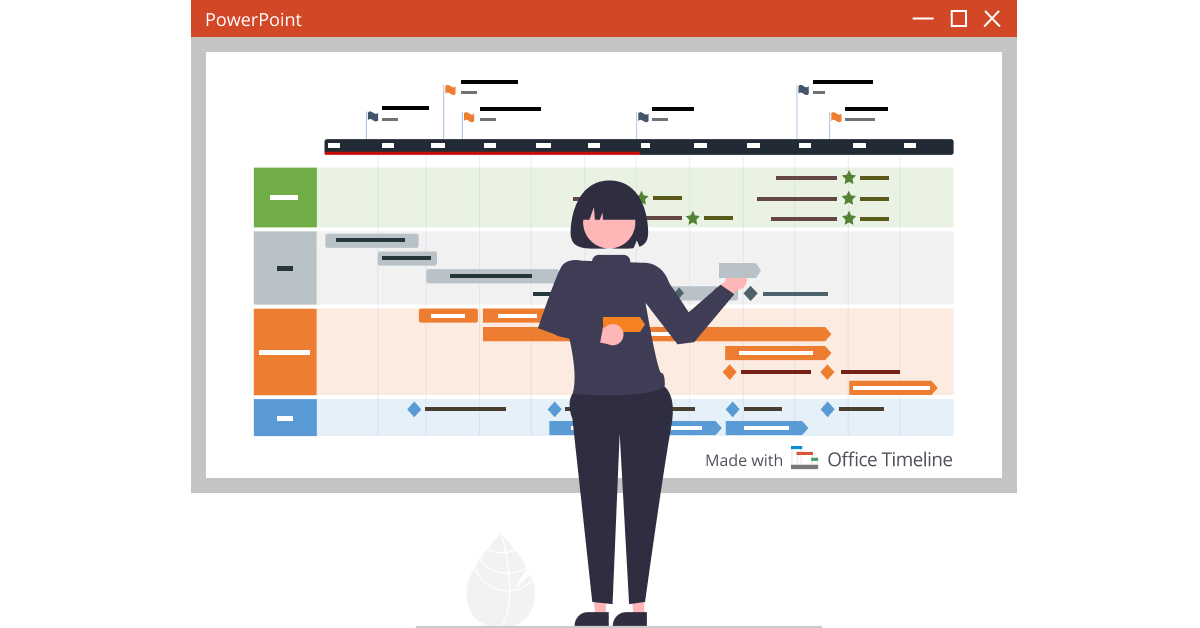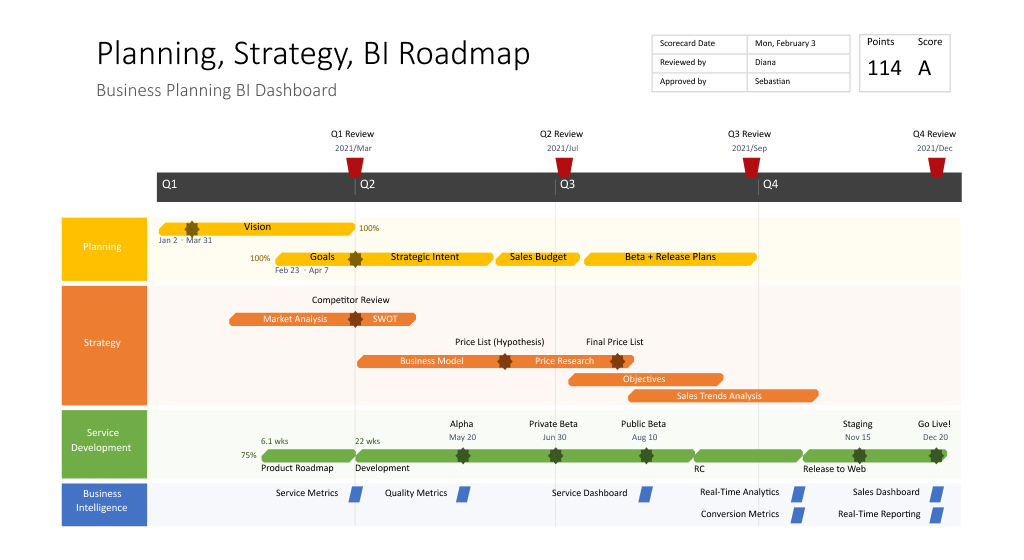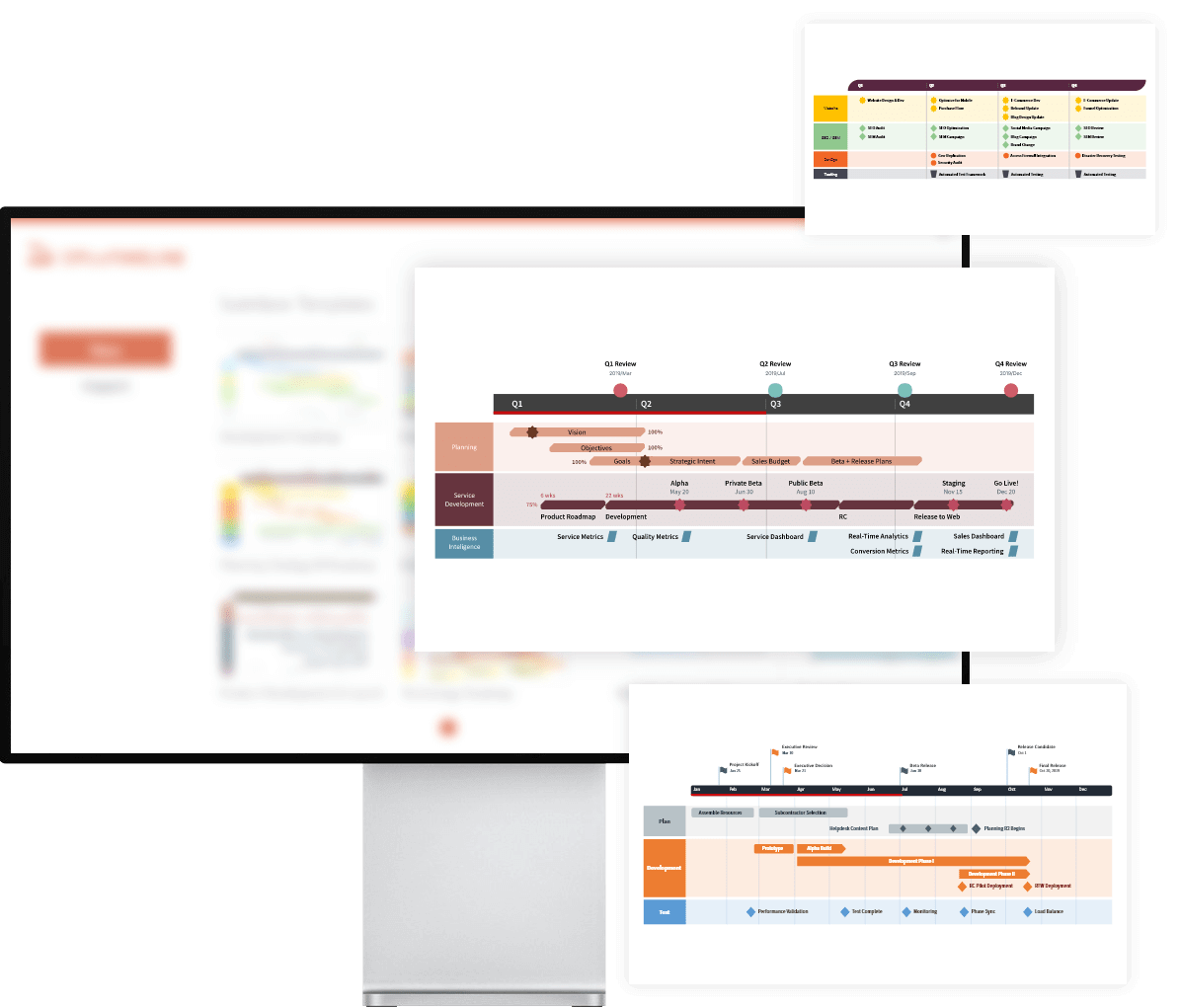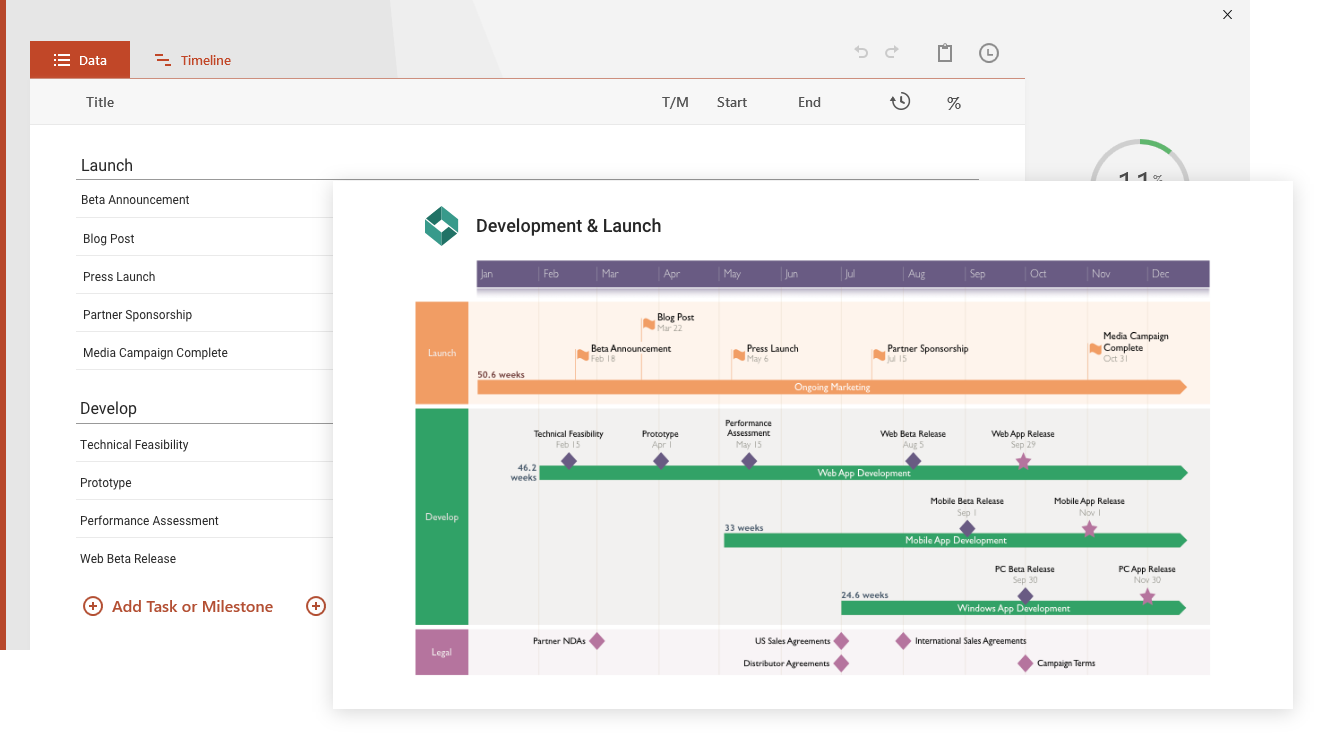
Getting Started with Roadmaps
Strategic planning is an essential part of managing projects or activities of any kind, and it's especially important in implementing your business vision. A simple visual like a roadmap provides a clear overview of your strategic tasks and milestones and helps you define a long-term plan for reaching your goals.
We've put together some resources to make it easier for you to create and manage your project or product roadmap. Here, you'll find all you need to know, from what a roadmap is to useful examples, friendly tools and free roadmap templates so you don't have to build them yourself. Let's get started!
What Is a Roadmap in Project Management?
Simply put, a roadmap is a strategic planning technique that places a project's goals and major deliverables (tasks, milestones) on a timeline, all grouped in a single visual representation or graphic. You should always remember that a roadmap planner differs from a regular project plan in that it doesn't contain all the details of a project; instead, it's a high-level, easy-to-understand, strategic tool.
Characteristics of a Roadmap
Defining an overall goal along with the major steps needed to reach it, a roadmap helps articulate the why behind the desired outcome and the plan for getting there within all kinds of strategic initiatives.
To better understand the role of a roadmap, let us review what this strategic tool is and is not.
Why Do You Need a Roadmap?
Creating a well-thought-out roadmap helps businesses and project/product managers judiciously decide to what they choose to commit. Aligning each work item to the overall objective, roadmaps ensure that time and efforts are invested wisely and provide a strong foundation in terms of:
Showing the why behind a planned initiative, a roadmap benefits any type of business because:
Serving as the reference point for everything a team will focus on, a visual roadmap is extremely useful for product/project managers in high-level meetings with clients and executives because it helps you:
Roadmap Examples
The structure of a roadmap may vary from one project to another, but there are some key elements you should include in all your roadmaps. These are:
Goals and initiatives – defining the value that your product or project brings and how it delivers on business objectives.
Releases and milestones – stating when work will start and be delivered.
Features – showing the efforts that are prioritized based on their overall value.
Dependencies – highlighting interrelated work that might impact delivery.
To briefly recap, no matter the type of initiative it illustrates, a roadmap needs to tie together your strategy (the “why”), the actions that you need to take to achieve your goals (the “what”), and a timeline for completion (the “when”).
Take a look at the sample roadmap visual below to explore these key elements.
Roadmaps have a flexible format for presenting strategic information, so there's no industry standard we should follow. Each strategic initiative - from Marketing to HR, Operations, or IT - can adopt a different approach, but over time we've seen that most professionals use a roadmap creator to build one of the popular types of roadmaps below.
To help you save time, you can download these examples for free (we've built them using PowerPoint and the Office Timeline add-in) so you can get started right away.

E-commerce program roadmap
High-level roadmap with an overview of project, teams, and activities for an e-commerce program.

Clinical trial roadmap
Simple roadmap showing the trial phases and key milestones in a drug approval process.

Product development roadmap
A colorful roadmap with key milestones and sprint schedule for better planning a SaaS product.

Platform roadmap
Roadmap slide with swimlanes and project details for effective management of a platform development process.
OPEN GALLERY
E-commerce program roadmap
High-level roadmap with an overview of project, teams, and activities for an e-commerce program.
DOWNLOAD SLIDE
Clinical trial roadmap
Simple roadmap showing the trial phases and key milestones in a drug approval process.
DOWNLOAD SLIDE
Product development roadmap
A colorful roadmap with key milestones and sprint schedule for better planning a SaaS product.
DOWNLOAD SLIDE
Platform roadmap
Roadmap slide with swimlanes and project details for effective management of a platform development process.
DOWNLOAD SLIDE
There are many ways you can use these roadmap examples to make better decisions around your strategic initiatives. Explore the roadmap templates page to discover which one fits you best, then download and customize them as you like.
How to Create a Roadmap
Here are the main five steps to building an effective roadmap:
Define your strategy – this step requires you to outline the overall vision, goals, and initiatives. In-depth research into buying personas, product positioning and competitive analysis helps create critical context and the foundation for your strategy.
Review and assess potential features – use a scoring mechanism to weigh potential features and decide which of them bring the most value to your initiative.
Prioritize and determine requirements – break down the activities that best support your strategy into smaller units of work.
Organize work into phases – group your ranked list of features or major efforts into major releases or stages and define their duration.
Choose your roadmap view – decide the level of detail and manner in which you want to illustrate all of the above over a specific time frame. For example, you might want to highlight specific features or cross-functional dependencies that influence the course of your plan.
Once you have covered all the steps above, you can then proceed to actually building your visual either by using a roadmap template or a dedicated roadmap tool.
For comprehensive demonstrations on how to make a roadmap using various office tools, check out our collection of step-by-step tutorials.
Roadmap Templates
What Is a Roadmap Template?
A roadmap template is a pre-built roadmap sample that can be easily updated with custom data to fit your needs. It provides an already-done framework to specific cases, helping you save time and effort in creating such a visual.
Why Use a Roadmap Template?
Using a roadmap template makes it easier for you to capture and communicate your product/project plans as it offers a pre-made structure to your own data. Available in a professionally designed format, roadmap templates help you to quickly build a timeline on which you concisely illustrate your goals and initiatives, the efforts that support your strategy and the due dates for work completion. Moreover, you can easily update them as often as necessary and even re-use them for future initiatives without having to start from scratch all over again.
Start building your first roadmap with
our free downloadable roadmap templates that you can easily tailor to your requirements. While some of them allow you to share high-level business goals, others are more suitable for conveying a more detailed view of your initiatives. You can also find examples designed for certain types of industries or organizations.
Simply download your preferred model, input your project/product data, and enjoy a presentation-ready roadmap.
Ready-Made Roadmap Templates
A variety of professional, stand-alone templates that you can instantly customize into your own beautiful roadmap.
Whether you are starting a business, launching a new product, or coordinating a cross-functional project, a roadmap will enable you to visualize your strategic plan and turn it into reality. It represents the output of your planning process and will serve as the main tool to communicate your initiative to stakeholders in a compelling manner.
This is why it is crucial to use purpose-built
roadmap software that will allow you to easily develop and customize high-level visuals that you can effortlessly share with important audiences (executives, team members, other groups in your organization, and clients).
One such dedicated roadmap maker is the PowerPoint add-in called
Office Timeline. This intuitive tool helps you automatically generate clear, stylish roadmaps as PowerPoint slides that you can quickly update as often as necessary and share or present in meetings.
CREATE YOUR OWN ROADMAP
With so much at stake when it comes to creating your roadmap, it's no wonder that deciding which roadmap tool to use proves to be such a challenging task. To make it easier for you to choose a roadmap software, here are the top 5 things to consider when you review the many roadmap tools available on the market today:
Need more guidance in choosing a roadmap tool? Check out our dedicated section on
roadmap tools.
Best Practices for Roadmaps
To serve the purpose for which it was created, a roadmap needs to be:
So here are a series of guidelines on how to effectively update, share and present impactful roadmaps that convey relevant information in a quick and clear manner.
Tips on How to Share or Present a Roadmap
For product/project managers to efficiently present and share their roadmap, they need to consider their audience – who they are, what they need to know and why. This way, they can adjust the structure and level of detail of their visual so that the right information be conveyed to the right people in a visually appealing way.
Here are the elements that make for an impactful roadmap presentation:
Tips on How to Use or Update a Roadmap
As a high-level plan that describes the work required to achieve a goal along with a corresponding schedule, your roadmap should include a series of visual elements to be successfully used:
Since plans change and new opportunities or challenges may arise along the way, you will want to create a flexible and dynamic roadmap that you can effortlessly update when such instances occur, not only quarterly or according to release status. To this end, choose an interactive dedicated tool that will allow you to:
Frequently Asked Questions about Roadmaps
Here are the answers to the most frequently asked question about roadmaps.
What is a roadmap?
A roadmap is the high-level, visual representation of the lifecycle of a business initiative, complete with the end goal, steps to take and milestones to reach along the way. The roadmap is primarily used for the strategic planning of projects and the development of new products.
What is a project roadmap?
A project roadmap is a strategic overview of a company-wide operation. It can define the scope, deliverables, high-level scheduling, milestones, challenges, and risk factors. Project roadmaps are slightly less detail-oriented than project timelines. The primary concern is respecting the original deadlines and adjusting deliverables to meet them, when required.
What does a roadmap include?
Long- and short-term objectives;
Tasks, milestones, and dependencies;
Resources required and their allocation strategy;
Timeline of the project’s lifecycle;
Risk factors and challenges.
Why is a roadmap important?
Roadmaps allow all involved parties to evaluate the competitiveness of a strategy, raise issues and reveal gaps, correctly prioritize resource allocation, and set realistic targets based on market data. They provide the framework for interdepartmental collaboration. Without roadmaps, every venture is a journey into the unknown and the risk of project failure grows higher.
How do you create a roadmap?
Starting off with a specialized roadmap maker application like Office Timeline can save you hours of work, allowing you to focus on the project specifics rather than graphic design. Here are the basic steps for creating a roadmap:
Define the timeline and project phases.
List the tasks, milestones, and dependencies.
Break down the workstream using logical containers like swimlanes.
Keep updating the roadmap with new developments.















